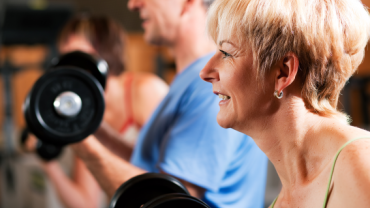
When we hear the phrase bone mineral density (BMD) we typically think of osteoporosis and when we hear that we typically think of women. More specifically what comes to mind is the image of a frail hunched-over elderly woman. But the loss of bone strength in older age isn’t the exclusive purview of women. While hormonal changes after menopause certainly play a role in the loss of bone mass in women men are not immune to brittle bones as they age.
When it comes to nutritional support for strong and healthy bones there’s calcium vitamin D and a host of additional bone-supporting nutrients such as vitamin K2 magnesium boron and phosphorus. Adequate nutrients are important of course. But also important—and perhaps somewhat underappreciated—is the role of physical activity in stimulating bone mineralization and maintenance of strong bones. The mere presence of the required nutrients is helpful but the “one-two punch” may come from giving the body a physical stimulus to do something with those nutrients.
With this in mind it’s a shame that women with osteoporosis are sometimes cautioned against heavy lifting or high-intensity loading due to concerns about injury. These concerns are legitimate but researchers have noted “safety concerns alone have prevented the well-recognised preferential response of bone tissue to high-intensity loads from being applied to those who stand to benefit the most.” (Emphasis added.) Weightlifting can help strengthen bone mass. In a small study (n=28) of post-menopausal women (age 66.1 ± 4.8 years) with low to very low bone mass subjects who participated in 8 months of twice-weekly 30-minute sessions of supervised high-intensity progressive resistance training had improved height and femoral neck and lumbar spine BMD compared to subjects whose intervention involved a low-intensity home-based exercise program of the same duration and dose. (And there were no injuries.)
Other research supports the benefits of resistance training on bone mass in older women. In a study in which 37 women with decreased muscle strength performed supervised resistance training in 60-minute sessions three times weekly for 16 weeks hip BMD increased by 6 percent. Six percent might not be much to write home about but when a fracture or break from a fall could mean a significant loss of mobility or independence perhaps that small amount of improvement would make all the difference. Unfortunately at the one-year follow-up the improvements hadn’t persisted and hip BMD had decreased back to baseline. This should not mislead us into thinking that strength training is not effective for improving BMD; what it more likely indicates is that resistance training has to be kept up in order to yield lasting results. Like brushing your teeth you can’t expect to do it for a few months and then continue to reap the benefits without ever having to do it again. It’s a habit that must be maintained regularly in order to keep showing efficacy.
(As an aside the authors of this study referred to the subjects as “elderly” with a mean age of 71.9 ± 3.1 years. Age is perhaps a subjective measure. There are millions of men and women in their early seventies who would likely balk at being called elderly!)
It would be interesting to see the effects on BMD from resistance training combined with a higher protein intake. Older individuals may need more protein than the RDA of 0.8g/kg and many do not even consume that much. (A better goal for older people might be 1.0-1.25g/kg/day.) In the past there had been concerns about the effects on skeletal mass from the potential acid load of an increased protein intake particularly from animal sources but other data show that a higher protein intake—including from meat—has no adverse effects on bone health. In fact low protein intakes are associated with detrimental changes to calcium and bone homeostasis while consuming more protein than the current RDA is beneficial for calcium utilization and bone health particularly among older people.
Now let’s not forget the men! Lifting weights isn’t only for young men to get buff and “turn all the girls’ heads.” Men with osteopenia of the hip or spine (mean age 44 ± 2 yrs) who performed 12 months of resistance training (twice weekly) had improvements in whole body total hip and lumbar spine BMD leading researchers to write “exercise may be the appropriate ‘prescription’ for some individuals with low bone mass.”
Any kind of load-bearing exercise—even just walking—could be beneficial but a systematic review of trials looking at the effects of weight-bearing and resistance exercise on BMD in middle-aged and older men found that resistance training and impact-loading were the most effective for increasing bone mass while walking trials had more limited effects. The authors stated that the latter “should be considered as a strategy to prevent osteoporosis in middle-aged and older men.”
In short lifting weights might improve people’s perceptions of what they see in the mirror but more important improvements might come in places they can’t see: their bones.